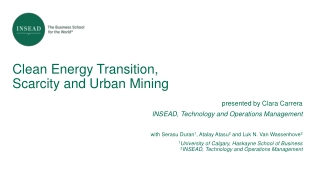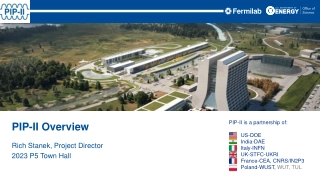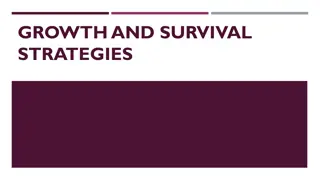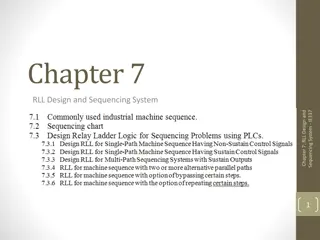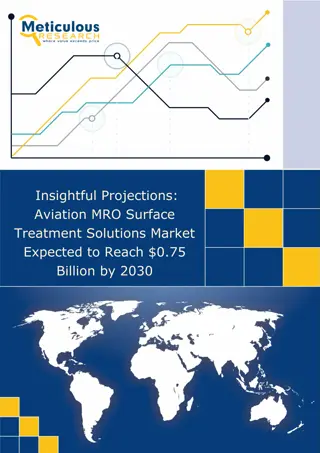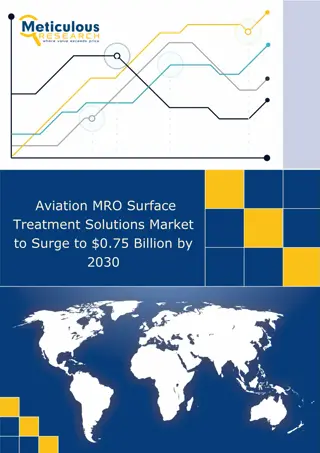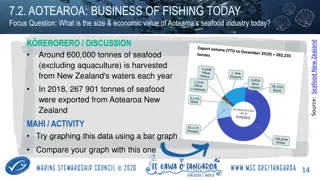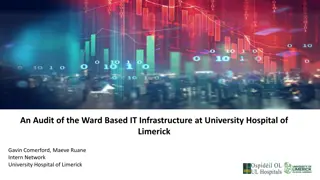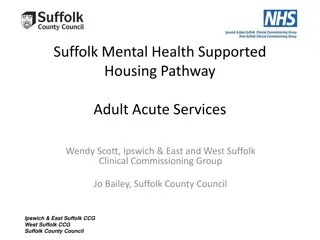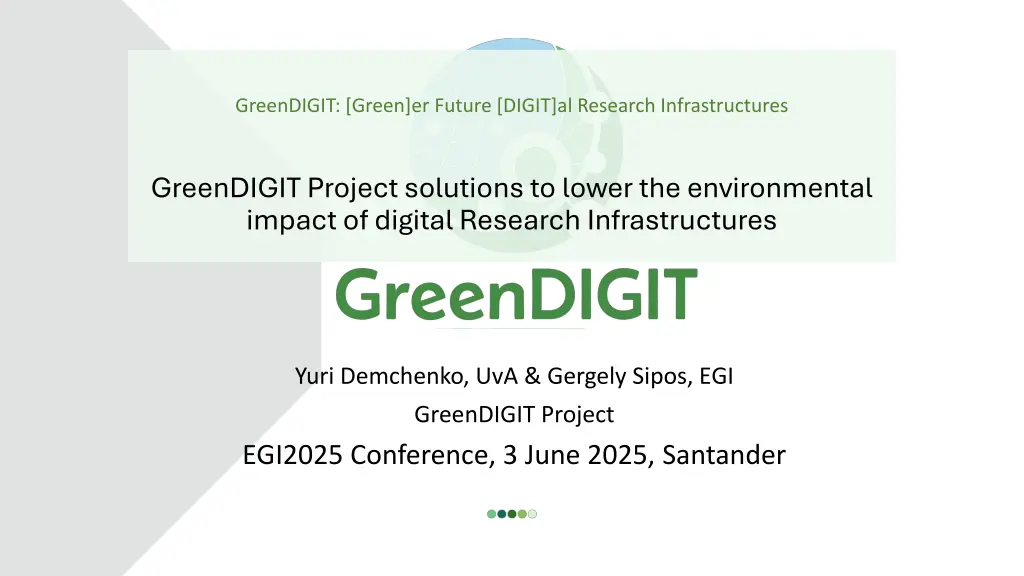
Sustainable Digital Research Infrastructures Solutions
GreenDIGIT Project focuses on developing sustainable digital research infrastructures to lower environmental impact, emphasizing energy efficiency, decarbonization, and reducing overall environmental footprint. The project's scope includes defining architecture pillars, implementing shared responsibility models, and establishing metrics for monitoring sustainability. Through collaborations with EU ESFRI Research Infrastructures, GreenDIGIT aims to promote a greener future for research ecosystems.
Download Presentation

Please find below an Image/Link to download the presentation.
The content on the website is provided AS IS for your information and personal use only. It may not be sold, licensed, or shared on other websites without obtaining consent from the author. If you encounter any issues during the download, it is possible that the publisher has removed the file from their server.
You are allowed to download the files provided on this website for personal or commercial use, subject to the condition that they are used lawfully. All files are the property of their respective owners.
The content on the website is provided AS IS for your information and personal use only. It may not be sold, licensed, or shared on other websites without obtaining consent from the author.
E N D
Presentation Transcript
GreenDIGIT: [Green]er Future [DIGIT]al Research Infrastructures GreenDIGIT Project solutions to lower the environmental impact of digital Research Infrastructures Yuri Demchenko, UvA & Gergely Sipos, EGI GreenDIGIT Project EGI2025 Conference, 3 June 2025, Santander
Outline GreenDIGIT project scope and goals Founding EU ESFRI Research Infrastructures: SoBigData, EBRAINS, SLICES, EGI Shared Responsibility Model for Sustainability RI Roles and Actors: RI providers/operators Research applications developers Researchers Architecture Framework for RI Sustainability by Design: Five Architecture Pillars compliant with Multilayer RI Architecture RI Lifecycle Model and related policies and regulations Metrics and Monitoring Infrastructure for RI Sustainability Funded by the European Union. Grant ID: 101131207 Disclaimer: Funded by the European Union. Views and opinions expressed are however those of the author(s) only and do not necessarily reflect those of the European Union. Neither the European Union nor the granting authority can be held responsible for them. GreenDIGIT @EGI2025 GreenDIGIT Outcomes and Solution for Green RIs 2
Sustainability Aspects: Energy Efficiency Decarbonisation Environmental Impact Energy Efficiency of Digital Infrastructures: Definition: This refers to optimizing digital infrastructures to consume as little energy as possible for a given workload or service. It's about achieving more computational or storage results with less energy input. Decarbonization of Digital Infrastructures: Definition: This specifically targets the reduction of carbon emissions associated with the operation and maintenance of digital infrastructures. Reducing Environmental Impact of Digital Infrastructures: Definition: This is a more comprehensive consideration of the various ways digital infrastructures might affect the environment, going beyond just energy consumption and carbon emissions. Architecture, Design, Recommendations Operation, Monitoring, KPI Lifecycle, Policy, Training GreenDIGIT @EGI2025 GreenDIGIT Outcomes and Solution for Green RIs 3
Importance of the Architecture definition Architecture is a way to coordinate/synch/unite Developers of Infrastructure and Applications Operators Users/Researchers Policy and decision makers Refer to TOGAF architecture principles (as an approach accepted by the majority of businesses) A basis for linking standards and regulations to architecture functional components Ensure compliance of the designed/developed RI and services (including for audit) GreenDIGIT @EGI2025 GreenDIGIT Outcomes and Solution for Green RIs 4
GreenDIGIT Architecture Definition Methodology General view on the RI Ecosystem Optimisation and Green IT Horizontal, vertical, lifecycle RI Operators and Researchers RI continuum: (Research Object) Sensor - (RAN) Edge Cloud Workflow - Researcher Sustainable architecture design principles As a basis for modelling and metrics for RI infrastructure operation and optimisation Shared Responsibility Model: RI provider/operator and Researchers/Projects Sustainability by design A novel concept to be introduced to address different aspects and stages Linkage with existing Standards and Regulations to ensure Sustainable Architecture Design principles support compliance with the standards, regulations and audit To provide the opportunity for RI/datacenter operation (and design) optimisation (through the whole lifecycle) System Engineering and Design (thinking) approach in Green research and technologies Sustainable (Durable) Architecture Design Principles GreenDIGIT @EGI2025 GreenDIGIT Outcomes and Solution for Green RIs 5
Shared Responsibility in Sustainability Reflecting Operational and Management Aspects and Roles Research Environment and Development Tools Research/Experiment Description and Data Model Project/Researcher Responsibility: Applications Development, Deployment, Jobs submission & Energy Efficiency optimisation Operation, Workflow execution Energy usage and KPI monitoring Design & Developm Users responsible for sustainability on the RI Application Software Design Virt RI Mngt & Operation Platform Deployment and Scaling Utilisation & Scaling Sci Workflow, App Energy Efficiency Data Storage Experimenter/Researcher Demand: Access to datacenter (internal) monitoring data and custom configuration Energy usage and KPI & metrics monitoring Exchange resources availability and status, monitoring metrics and KPI (API, Info model) RI Virtualisation Platform Datacenter Resource Provision DC Mngnt & Operat Data Collect&Monit Network Comp Cluster Storage Provider/Operator Responsibility: Operation of Research Infrastructure or Datacenter, Monitoring Energy: environmental impact metrics and KPI Waste Lifecycle and evolution Electricity Supply DC/RI Operation Monitoring Energy Consumption Providers responsible for the sustainability ofthe RI Building, Equipm, Waste Light, Logistics Cooling Water Datacenter & Digital Infrastructure Resources/Platform GreenDIGIT Outcomes and Solution for Green RIs GreenDIGIT @EGI2025 6
RI Sustainability by Design Components/Aspects: Motivated by the Shared Responsibility Model Pillar 1 Layered and Modular Architecture for Sustainable Digital Infrastructur Functional components, Layers, API, Requirements Pillar 2 - Software and Scientific Applications Design Patterns for Energy Efficiency and Environmental Impact Reduction Green aware API including necessary energy, performance, environment information Pillar 3 - Lifecycle-Oriented Sustainability Management of Research Infrastructures and Scientific Applications RI lifecycle stages (concept, design, development, deployment, operation, decommissioning) and scientific workflow and research data (!) Pillar 4 Interoperable/common Information Models for Sustainability Metrics and Monitoring Including Requirements, KPI, Metrics + FAIR for Sustainability Pillar 5 - Sustainable Data Management and Energy-Efficient Storage Systems Researcher/ Project Responsibility: Applications Development, Energy usage and KPI monitoring Users responsible for sustainability on the RI Sustainability by Design Pillars/Challenges RI/Datacenter Provider/Operator Responsibility: Monitoring Energy and environmental impact, metrics and KPI Providers responsible for the sustainability ofthe RI GreenDIGIT @EGI2025 GreenDIGIT Outcomes and Solution for Green RIs 7
Five Pillars Architecture Framework for Sustainability by Design and RI Layered Architecture Researcher/Organisation Pillar 1 Layered and Modular Architecture for Sustainable Digital Infrastructur Functional components, Layers, API, Requirements Pillar 2 - Software and Scientific Applications Design Patterns for Energy Efficiency and Environmental Impact Reduction Green aware API including necessary energy, performance, environment information Pillar 3 - Lifecycle-Oriented Sustainability Management of Research Infrastructures and Scientific Applications RI lifecycle stages (concept, design, development, deployment, operation, decommissioning) and scientific workflow and research data (!) Pillar 4 Interoperable/common Information Models for Sustainability Metrics and Monitoring Including Requirements, KPI, Metrics + FAIR for Sustainability Pillar 5 - Sustainable Data Management and Energy-Efficient Storage Systems Data Management (FAIR) L5 Research Tools and Portal Dev Tools, IDE/SDK, Advice/ Assess Data, Workflow/SW Control, Mngnt Scientific Workflow & Research Development Environment L4 Exchange API for Resource Usage Optimisation Platform for RI Virtualisation and Provisioning L3 Exchange API for monitoring and KPI Cloud and Virtualised Infrastructure Resources and Provisioning L2 Datacenter & Infrastructure Resources L1 Storage Network Compute GreenDIGIT @EGI2025 GreenDIGIT Outcomes and Solution for Green RIs 8
5 Pillars Architecture Framework for Sustainability by Design - Technical Pillar 1 Layered and Modular Architecture for Sustainable Digital Infrastructure Pillar 2 - Software and Scientific Applications Design Patterns for Energy Efficiency and Environmental Impact Reduction Pillar 3 - Lifecycle-Oriented Sustainability Management of Research Infrastructures and Scientific Applications Pillar 4 Interoperable/common Information Models for Sustainability Metrics and Monitoring Pillar 5 - Sustainable Data Management and Energy-Efficient Storage Systems GreenDIGIT @EGI2025 Standards and Regulations for Green RIs 9
Architecture Framework Pillars Technical Pillars 1-3 Details Pillar 1 Layered and Modular Architecture for Sustainable Digital Infrastructure Benefits of layers definition: Benefit of layered architecture is that it makes it easier to support dynamic energy-aware orchestration across layers (actually using the same API/infomodel) Pillar 2 - Software and Scientific Applications Design Patterns for Energy Efficiency and Environmental Impact Reduction Goal and benefits: Primarily focus on scientific workflows and user-driven applications for energy efficiency awareness. Allows to benefit from (general) green software engineering and (research focused) reproducible (experimental) science. Links application design to infrastructure energy-aware execution. Pillar 3 - Lifecycle-Oriented Sustainability Management of Research Infrastructures and Scientific Applications Goal and benefits: Lifecycle stages define different actors and requirements to RI components and services Incorporate LCA methodologies LCA methodologies to evaluate and mitigate environmental impacts throughout the RI's operational life GreenDIGIT @EGI2025 GreenDIGIT Outcomes and Solution for Green RIs 10
Architecture Framework Pillars Technical Pillars 4-5 Details Pillar 4 Interoperable/common Information Models for Sustainability Metrics and Monitoring Goal and benefit: Ensures semantic interoperability for API definition and machine-actionability. Simplifies infrastructure metrics telemetry with regulatory reporting needs. Cross-infrastructure benchmarking and optimization Pillar 5 - Sustainable Data Management and Energy-Efficient Storage Systems Goal and benefits: Efficient data management practices contribute to the overall sustainability of RIs Implement tiered storage architectures and data compression techniques to reduce energy consumption associated with data storage and retrieval Linking FAIR data principles for sustainability metadata: Important for RI/EOSC liaison but needs some additional definitions GreenDIGIT @EGI2025 GreenDIGIT Outcomes and Solution for Green RIs 11
Architecture Framework Pillars (Additional) Pillars 6-7 To address ESFRI RM2026 Environmental Sustainability Requirements Additional pillars to extend the sustainability architecture of future DRIs and scientific applications and address critical gaps and emerging needs in areas such as governance and policy integration, which are essential to achieving environmental sustainability goals through the DRI lifecycle (ensuring alignment with ESFRI Roadmap 2026): Pillar 6 Governance, Policy Integration, and Compliance Framework Establish clear governance models that incorporate sustainability objectives, ensuring accountability and continuous alignment with ESFRI's evolving requirements. Provide a basis for interoperability and energy-aware infrastructure federation, adopt interoperable standards for data exchange across federated infrastructures. Pillar 7 User Awareness, Behavior, and training for Sustainability by Design Develop training programs and user interfaces that encourage energy-efficient behaviors and provide feedback on the environmental impact of user activities GreenDIGIT @EGI2025 GreenDIGIT Outcomes and Solution for Green RIs 12
Digital RI Lifecycle Stages (ESFRI Compliant) Concept Development Design Development Deployment and Pre-operation Operation & Evolution Termination/Decommissioning GreenDIGIT @EGI2025 GreenDIGIT Outcomes and Solution for Green RIs 13
GreenDIGIT: RI Lifecycle Stages, Activities and Factors Scientific Workflow Experiments Exec. + Data Collection External reference information: Energy Efficiency, CO2, geo-energy , smartgrids, git/patterns Standards, Regulations Reuse/ Refurbish Operation/ Evolution (RI/DC Platform & Sci WF/Apps) Preparation Development Concept Development Implement / Deployment Researcher/ Proj Coord SW & Storage recycle Design Termination Ideation-to-Design SotA Users/Actors Use cases Requirements Engineering Architecture Standards/Regulations Design & Development Architecture & Design principles DevOps & DevSecOps Info data model Git, patterns, metrics, schemas, Repository API/WebAPI Testing, Logbook Project Management Tech Documentation Report, Compliance Waste Operation Processes DevOps/SRE/DevGreenOps Monitoring, Metrics, KPI Maintenance Update/Upgrade/Procurement Audit, Certification Electricity, Water, Buildings Implementation CI/CD SW/HW & Implement Platform/Cloud Feedback to Dev Circular Economy Research Infrastructure Lifecycle All stages and processes to be in compliance with standards and regulations Shared Responsibility model and User /operator tools Continuous monitoring GreenDIGIT Outcomes and Solution for Green RIs GreenDIGIT @EGI2025 14
RI Lifecycle Model: Stages, Actors, Activities RI Lifecycle Stage Involved Actors Activities RI Concept development Researchers (target RI users) Infrastructure and System Engineering team (professional, experienced) Concept development (Ideation- for-Design) SotA analysis Users/Actors, Use cases analysis, Requirements Engineering Architecture, Standards/Regulations analysis Design & Development Architecture & Design principles DevOps & DevSecOps, Project Management Info data model, API/WebAPI Git, patterns, metrics, schemas, Repository, Testing, Logbook Tech Documentation, Reporting, Compliance Implementation CI/CD SW/HW & Implement Platform/Cloud Design and Development (preparation) Researchers (consulting of domain related research facilities) Infrastructure and System Engineering team (professional, experienced) Application and service developers Project management Implementation, Deployment (pre- operation) Researchers (for pre-op testing) Infrastructure and System Engineering team Project management RI Management (including staffing and financial aspects) Operation team (Potentially, sustainability officer) Management Operator team Operation Operation Processes Monitoring, Metrics, KPI, DevOps/SRE Maintenance, Audit, Certification Electricity, Water, Buildings Termination procedure Termination/Decommission plan and procedure, including recycle and circular economy procedures, Waste utilisation Data archiving or migrating, secure storage recycling Termination GreenDIGIT @EGI2025 GreenDIGIT Outcomes and Solution for Green RIs 15
GreenDIGIT: RI Lifecycle Stages, Regulations, Impact Factors Lifecycle Assessment (LCA) (ISO 14040, ISO 14044) Goal&Scope LC Inventory Analysis LC Impact Analysis Interpretation Other Regulations and Policies CNDCP UN Dig PInfra SBTi EU Green Deal Regulations WEEE EED ESPR ESRS/CSRD (EU) Reuse/ Refurbish Operation/ Evolution (RI/DC Platform & Sci WF/Apps) SW & Storage recycle Preparation Development Concept Development Implement / Deployment Researcher/ Proj Coord Design Termination Waste JRC/EU CoC for DC Circular Economy LCA Impact Metrics (Operational & Termination stages) Climate change (energy, cooling) (kg CO -eq.) Water use footprint (regional) (m water) Waste generation (WEEE) (kg or tonnes electronic waste) Resource depletion (rare/non- renewable) (kg Sb-eq.; MJ) Energy Efficiency, Environmental Impact for Monitoring&Mngnt PUE - Power Usage Effectiveness CUE - Carbon Usage Effectiveness WUE - Water Usage Effectiveness REF - Renewable Energy Factor ERF - Energy Reuse Factor GreenDIGIT Outcomes and Solution for Green RIs ISO50001/EN50600 ISO 30134 DC ISO 14001 EMS Energy, Env MgntSys GreenDIGIT @EGI2025 16
ESFRI Roadmap 2026: Research Infrastructure Lifecycle Model and Requirements RILM stages Compliant with ESFRI Lifecycle stages Reporting on Energy Efficiency and Environmental Sustainability ESRS/CSRD and ESFRI RM2026 Link to standards and regulations Digital RI related ESFRI Roadmap 2026 To be analysed due to ESRS reporting specifics on Groups E1 - Climate, E2 - Pollution, E3 Water and marine resources, E4 Biodiversity and ecosystems, E5 Resource use and circular economy E1 group compliance: E1-1, E1-2, E1-3 Climate mitigation target, policies, actions; E1-4 - targets; E1-5 Energy consumption and mix; E1-6 Total GHG emission; E1-9 Potential financial effect of measures Compliance with LCA Roles and activities GreenDIGIT @EGI2025 GreenDIGIT Outcomes and Solution for Green RIs 17
GreenDIGIT: European Policies and Regulations for Development and Compliance European Strategy Forum on Research Infrastructure (EFRI) Roadmap 2026: Environmental Sustainability of the European/ESFRI Research Infrastructures Compliance with ESRS (European Sustainability Reporting Standard) compliant with EU CSRD (Corporate Sustainability Reproting Directive) European Code of Conduct for Data Centers JRC BCP Sections 2024 Best Practice Guidelines for the EU CoC on Data Centre Energy Efficiency Commission Delegated Regulation (EU) 2024/1364 of 14 March 2024 for Data centers ISO/EN/ITU-T Standards Compliance Basis for Certification and Audit ISO 50000, ISO 30134, ISO 14002 ISO 14040, ISO 14044 LifeCycle Analysis (LCA) EN 50600-4-1 and EN 50600-4-2 Datacenter and supporting infrastructure GreenDIGIT @EGI2025 GreenDIGIT Outcomes and Solution for Green RIs 18
Policies and Regulations for Energy Efficiency and Environmental Sustainability (GreenDIGIT Milestone Report MS4/MS8.1 50 pp.) Policies related to environmental sustainability and energy efficiency UN Sustainable development goals (SDG) UN Digital Public Infrastructure for Environmental Sustainability SBTi: The Science Based Targets Initiative The European Green Deal Climate Neutral Data Centre Pact (CNDCP) ESFRI Roadmap 2026 Public Guide European Regulations and Directives JRC Data Center Code of Conduct EU Delegated Regulation (EU) 2024/1364 of 14 March 2024 Corporate Sustainability Reporting Directive (CSRD) and European Sustainability Reporting Standards (ESRS) Ecodesign for Sustainable Products Regulation (ESPR) Energy Efficiency Directive (EED) Waste Electrical and Electronic Equipment (WEEE) Directive Lifecycle Analysis (LCA) & ISO 14040, ISO 14044 Environmental Management Standards (EMS) Energy Management Systems ISO 50001, ISO 50002, ISO 14001, ISO 30134 European standards series EN 50600: EN 50600-4-1 and EN 50600-4-2 Datacenter and supporting infrastructure GreenDIGIT @EGI2025 GreenDIGIT Outcomes and Solution for Green RIs 19
Architecture for RI Sustainability Metrics and Monitoring Architecture for Metrics and Optimisation Environmental Metrics Infrastructure: Collection, Management and Reporting GreenDIGIT @EGI2025 GreenDIGIT Outcomes and Solution for Green RIs 20
RI environmental Impact Assessment ESFRI Lifecycle Product Environmental Footprint https://green-business.ec.europa.eu/environmental-footprint-methods/pef- method_en
Architecture for Metrics and Optimisation Level 1 Developer tools for energy efficient software design Optimised code; Prevent re-execution of already conducted experiments Level 2 Energy efficiency aware schedulers Reshuffle jobs based on site carbon intensity attributes Level 3 Energy efficiency aware resources manager Delay execution based on electricity cost, regulations, carbon intensity, resources turning on-off Metrics Infrastructure Gather relevant environmental impact metrics Serve metrics to decision making systems (schedulers, researcher tools, VREs) Present statistics and monitoring in dashboards Environmental metrics Level 1: RDE, Experiment Developer environment RI manager Dashboard Publisher Researcher Site Publisher Level 2: Infrastructure Composition/ Scheduling Site Environmental metrics Broker Publisher Site Site Level 3: Site, Resources Management Resources Publisher R R Resource optimiser Environmental metrics R R Site manager Dashboard GreenDIGIT @EGI2025 GreenDIGIT Outcomes and Solution for Green RIs 22
Environmental Metrics Infrastructure: Management and Reporting CO2[kg] caused by Task = Energy [kWh] * CO2intensity [kg/kWh] Carbon Footprint of an HTC job CO2 (job) = HS23 * PS23 * PUE * CI [gCO2] = [HEPScore23 * time] * [Watt / HEPScore23] * [%] * [gCO2 / (Watt * time)] Carbon Footprint of Virtual Machine (cloud) CO2 (VM) = E * ITUE * PUE * CI [gCO2] = [Watt * time] * [%] * [%] * [gCO2 / (Watt * time)] GreenDIGIT @EGI2025 GreenDIGIT Outcomes and Solution for Green RIs 23
Discussion: Greening Digital RIs Environmental sustainability in the ESFRI Roadmap 2026 Cooperation with/between digital RIs GreenDIGIT cooperating partners: SLICES, SoBigData, EBRAINS, and EGI Possible topics for discussion with a technical focus T1 - Sustainability landscape T3 - Shared Responsibility in Environmental Sustainability T4 - Energy efficiency on/of Research Infrastructure/Research Environment T2 - Environmental Sustainability and emerging GenAI/LLM powered science GreenSys2025 Workshop GreenDIGIT Project for Greenng Future DIgital Infrastructures 24
T1 - Sustainability landscape Sustainability is overloaded term Many economy and social domains claim to do sustainability, mostly focusing on sustainable/continuous activity and durable solutions Questions What are the most active sustainability domains in your view? How are they connected? How to unite/merge/converge sustainability activity/development in different domains? What are different actors and interests? What community, projects, governmental and research bodies can do? GreenSys2025 Workshop GreenDIGIT Project for Greenng Future DIgital Infrastructures 25
T2 - Environmental Sustainability and emerging GenAI/LLM powered science Expected growing use and benefits from powering science with GenAI and LLM for discovery and Data Science/ML for scientific data processing Required huge amount of energy for GenAI/LLM and ML is rising concerns about environmental sustainability and impact Questions How is this problem perceived by the research community? Risk or sacrifice environment protection? What can be controlled by researchers? Regulation/limitation vs training and thoughtful environment aware use? What technical solutions can be researched or proposed for sustainable GenAI infrastructure? GreenSys2025 Workshop GreenDIGIT Project for Greenng Future DIgital Infrastructures 26
T3 - Shared Responsibility in Environmental Sustainability Shared responsibility model is known in many domains. GreenDIGIT is proposing the Shared Responsibility Model for greening the whole RI ecosystem that describes responsibility of different stakeholders on different physical, software and operational elements of RIs Researchers/user and providers and operators are defined Questions What are responsibilities? What are other stakeholders? What information needs to be exchanged between stakeholders and functional RI components/services to facilitate decision on sustainability? Sustainability aware tools for scientific workflow management? What are their expected functionalities? GreenSys2025 Workshop GreenDIGIT Project for Greenng Future DIgital Infrastructures 27
T4 - Energy efficiency on/of Research Infrastructure/Research Environment Energy efficiency and environment impact monitoring and management is important area that is defined by numerous standards and regulations It is also a required reporting according many national programs and regulations Questions What are existing/known to audience practices? How to monitor and optimise energy efficiency and environmental impact of datacenters, RIs and research facilities? What to measure and what is required metrics? What are known methods and research regarding energy efficiency? GreenSys2025 Workshop GreenDIGIT Project for Greenng Future DIgital Infrastructures 28
Additional Information Green competences and training for researchers and RI operators Proposed groups of tutorials for the target groups of RI organisational roles GreenDIGIT @EGI2025 GreenDIGIT Outcomes and Solution for Green RIs 29
Green Competences for Environmental Sustainability and Suggested Thematic Tutorial Groups GRIU: General researchers (RI users) and experimental researchers on RI SSES: Research application developers (Software and System Engineering for Sustainability) RIOS: Technical staff of RI operator on monitoring Environmental Sustainability GESA: General Environmental Sustainability Competences and Knowledge (Green and Environmental Sustainability Awareness) MEB: Tutorials and executive briefings for the RI management roles GreenDIGIT @EGI2025 GreenDIGIT Outcomes and Solution for Green RIs 30


